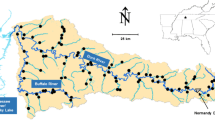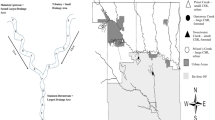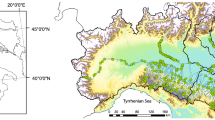Abstract
Much has been written about the influence of exotic or nonindigenous species on natural habitats and communities of organisms, but little is known of the physical or biological conditions that lead to successful invasion of native habitats and communities by exotics. We studied invasivity factors in headwater streams of the Susquehanna River West Branch, which drains portions of the northern Appalachian Plateau. A replicated (two major tributaries) 3 × 3 factorial design was used to determine landscape effects of size (stream order) and quality (land use) on abiotic (physical and chemical) and biotic (fish community structure and function) stream attributes. Seven (21%) of thirty-four fish species (brown trout, common carp, mimic shiner, bluegill, smallmouth bass, fantail darter, and banded darter) collected in the eighteen streams sampled were nonindigenous to the basin. Watershed size (stream orders 1, 3, and 5) significantly affected stream geomorphologic and habitat variables (gradient, width, depth, current velocity, diel water temperature, bank overhang, canopy cover, and woody debris density) but not water-quality variables, while land use in watersheds (conservation, mining, and agriculture) significantly affected measured water-quality variables (alkalinity and concentrations of manganese, calcium, chloride, nitrate, and total dissolved solids) but not stream physical or habitat quality. Both watershed size and land use affected fish-community variables such as presence of particular species, species density, species diversity, tolerance diversity, and mean fish size, but in both cases the effect was transparent to native-origin status of fish species. No relationships were found between occurrence of nonindigenous species in watersheds and trophic structure or functional diversity. Therefore, the hypothesis that reduced species diversity increases vulnerability to nonindigenous species was not supported. However, the spatial variation associated with both water-quality and habitat-quality factors was greater in streams with mixed (those with nonindigenous species) than with exclusively native assemblages. These findings suggest that the mechanism for successful invasion by nonindigenous or exotic species is through change in water or habitat quality associated with human or natural disturbances, such as agriculture and mining activities in watersheds. Biotic factors appear to play no or a lesser role in the invasibility of northern Appalachian lotic systems.
Similar content being viewed by others
References
Allan JD andFlecker AS (1993) Biodiversity conservation in running waters. Bioscience 43(1): 32-43
American Fisheries Society (AFS) (1991) Common and scientific names of fishes from the United States and Canada. AFS Special Publication 20, Bethesda, Maryland, 183 pp
American Public Health Association (APHA), American Water Works Association and Water Pollution Control Federation (1985) Standard Methods for the Examination of Water and Wastewater (16th edn). American Public Health Association, New York, 269 pp
American Public Health Association (APHA), American Water Works Association and Water Pollution Control Federation (1989) Standard Methods for the Examination of Water and Wastewater (17th edn), pp 4.2-4.6. American Public Health Association, New York
Angermeier PL (1995) Ecological attributes of extinction-prone species: loss of freshwater fishes of Virginia. Conservation Biology 9(1): 143-158
Angermeier PL andWinston MR (1998) Local versus regional influences on local diversity in stream fish communities of Virginia. Ecology 79(3): 911-927
Argent DG (2000) Fish distribution patterns in Pennsylvania: anthropogenic influences and the status of rare fishes. PhD dissertation. College of Agricultural Sciences, Pennsylvania State University, University Park, 222 pp
Argent DG,Carline RF andStauffer Jr JR (1997) Historical and Contemporary Distribution of Fishes in Pennsylvania. USGS Research Work Order No. 47 Final Report, School of Forest Resources, Pennsylvania State University, University Park, Pennsylvania, 278 pp
Baltz DM andMoyle PB (1993) Invasion resistance to introduced species by a native assemblage of stream fishes. Ecological Applications 3: 246-255
Brenner FJ,Raup V andStiffler WF (1991) Characteristics of fish communities above and below six flood control impoundments in Mercer County, Pennsylvania. Journal of the Pennsylvania Academy of Sciences 65(1): 24-30
Brown LR andMoyle PB (1997) Invading species in the Eel River, California: successes, failures, and relationships with resident species. Environmental Biology of Fishes 49: 271-291
Carlson FT (1968) Suitability of the Susquehanna River for Restoration of Shad. USDI, Washington, DC, 60 pp
Commonwealth of Pennsylvania (1992) Water Quality Standards. PA Code, Title 25, Chapter 93, Department of Environmental Protection, Harrisburg, Pennsylvania
Cooper EL (1983) Fishes of Pennsylvania and the Northeastern United States. Pennsylvania State University Press, University Park, Pennsylvania, 243 pp
Cooper EL andWagner CC (1971) Fishes of Pine Creek, Pennsylvania. Pennsylvania State University, University Park, Pennsylvania, 39 pp
Courtenay WR andMoyle PB (1992) Crimes against biodiversity: the lasting legacy of fish introductions. Transactions of the North American Wildlife and Natural Resources Conference 57: 365-372
Council on Environmental Quality (CEQ) (1981) Environmental Trends. Executive Office of the President, Washington, DC, 346 pp
Department of Environmental Resources (DER) (1989) Pine Creek Scenic River Study. Pennsylvania Department of Environmental Resources, Harrisburg, Pennsylvania, 29 pp
Ehrlich PR andWilson EO (1991) Biodiversity studies: science and policy. Science 253: 758-762
Findlay CS,Bert DG andZheng L (2000) Effect of introduced piscivores on native minnow communities in Adirondack Lakes. Canadian Journal of Fisheries and Aquatic Science 57: 570-580
Frissell CA (1993) Topology of extinction and endangerment of native fishes in the Pacific Northwest and California (USA). Conservation Biology 7(2): 342-354
Garman GC andNielsen LA (1982) Piscivory by stocked brown trout (Salmo trutta) and its impact on the nongame fish community of Bottom Creek, Virginia. Canadian Journal of Fisheries and Aquatic Science 39: 862-869
Halliwell DB,Langdon RW,Daniels RA,Kurtenbach JP andJacobson RA (1999) Classification of freshwater fish species of the northeastern United States for use in the development of indices of biological integrity, with regional applications. (Chapter 12) In: Simon TP (ed) Assessing the Sustainability and Biological Integrity ofWater Resources Using Fish Communities pp. 301-337. CRC Press, Boca Raton, Florida
Heard RM,Sharpe WE,Carline RF andKimmel WG (1997) Episodic acidification and changes in fish diversity in Pennsylvania headwater streams. Transactions of the American Fisheries Society 126: 977-984
Hughey RE (1991) Aquatic Biological Investigation of Loyalsock Creek. Pennsylvania Department of Environmental Resources, Bureau of Water Quality Management Stream File 19804, Williamsport, Pennsylvania, 36 pp
Hughey RE (1992) Aquatic Biological Investigation of Little Loyalsock Creek, Sullivan County. Department of Environmental Resources, Bureau of Water Quality Management Stream File 20161, Williamsport, Pennsylvania, 23 pp
Jackson DA,Peres-Neto PR andOlden JD (2001) What controls who is where in freshwater fish commuities-the roles of biotic, abiotic, and spatial factors. Candian Journal of Fisheries and Aquatic Science 58: 157-170
Jones EB,Helfman GS,Harper JO andBolstad PV (1999) Effects of riparian forest removal on fish assemblages in southern Appalachian streams. Conservation Biology 13: 1454-1465
Karr JR (1981) Assessment of biotic integrity using fish communities. Fisheries 6: 21-27
Larsen DP,Omernik JM,Hughes RM,Rohm CM,Whittier TR,Kinney AJ,Gallant AL andDudley DR (1986) Correspondence between spatial patterns in fish assemblages in Ohio streams and aquatic ecoregions. Environmental Management 10(6): 815-828
Lemly AD (1985) Suppression of native fish populations by green sunfish in first-order streams of Piedmont North Carolina. Transactions of the American Fisheries Society 114: 705-712
Leonard PM andOrth DJ (1986) Application and testing of an index of biotic integrity in small, coolwater streams. Transactions of the American Fisheries Society 115: 401-414
Lodge DM (1993) Biological invasions: lessons for ecology. Trends in Ecology and Evolution 8: 133-137
LoVullo TJ andStauffer Jr JR (1993) The retail baitfish industry in Pennsylvania-source of introduced species. Journal of the Pennsylvania Academy of Sciences 67(1): 13-15
Lyons J,Wang L andSimonson TD (1996) Development and validation of an index of biotic integrity for coldwater streams in Wisconsin. North American Journal of Fisheries Management 16: 241-256
MacRae PS andJackson DA (2001) The influence of smallmouth bass (Micropterus dolomieu) predation and habitat complexity on the structure of littoral zone fish assemblages. Canadian Journal of Fisheries and Aquatic Science 58: 342-351
Maret TR,Robinson CT andMinshall GW (1997) Fish assemblages and environmental correlates in the least-disturbed streams of the upper Snake River basin. Transactions of the American Fisheries Society 126: 200-216
Master LL (1990) The imperiled status of North American aquatic animals. Biodiversity Network News (The Nature Conservancy) 3: 1-8
Master LL,Flack SR andStein BA (1998) Rivers of Life: Critical Watersheds for Protecting Freshwater Biodiversity. The Nature Conservancy, Arlington, Virginia, 71 pp
Miller RR,Williams JD andWilliams JE (1989) Extinctions of North American fishes during the past century. Fisheries 14: 22-38
Moyle PB and Light T (1996) Fish invasions in California: do abiotic factors determine success? Ecology 77(6): 1666-1670
Moyle PB,Brown LR andHerbold B (1986) Final Report on Development and Preliminary Tests of Indices of Biotic Integrity for California. Final Report to the US Environmental Protection Agency, Environmental Research Laboratory, Corvallis, Oregon, 89 pp
Newall PR andMagnuson JJ (1999) The importance of ecoregion versus drainage area on fish distributions in the St. Croix River and its tributaries. Environmental Biology of Fishes 55: 245-254
Omernik JM (1995) Ecoregions: a framework for environmental management. In: Davis W andSimon T (eds) Biological Assessment and Criteria: Tools for Water Resource Planning and Decision Making, pp 49-62. Lewis Publishers, Boca Raton, Florida
Orth DJ,Jones RN andMaughan OE (1981) Considerations in the development of curves for habitat suitability criteria. In: Armantrout NB (ed) Acquisition and Utilization of Aquatic Habitat Inventory Information, pp 124-133. Western Division American Fisheries Society, Portland, Oregon
Pinder MJ andMorgan RP (1995) Interactions of pH and habitat on cyprinid distributions in Appalachian streams of Maryland. Transactions of the American Fisheries Society 124: 94-102
Raesly RL,Stauffer Jr JR andDenoncourt RF (1990) Hybridization between two darters, Etheostoma zonale and Etheostoma olmstedi (Teleostei: Percidae) following an introduction event. Copeia 1990: 584-588
Reshetiloff K (ed) (1995) Chesapeake Bay: Introduction to an Ecosystem. Chesapeake Bay Program, Baltimore, Maryland, 28 pp
Ricciardi A andRasmussen JB (1999) Extinction rates of North American freshwater fauna. Conservation Biology 13(5): 1220-1222
Richards C,Host GE andArthur JW (1993) Identification of predominant environmental factors structuring stream macroinvertebrate communities within a large agricultural catchment. Freshwater Biology 29: 285-294
Richards C,Johnson LB andHost GE (1996) Landscape-scale influences on stream habitats and biota. Canadian Journal of Fisheries and Aquatic Science 53(Suppl. 1): 295-311
Richardson C (1995) Thank you, Mr. Norris! Pennsylvania Angler 64(10): 11-14
Richter BD,Braun DP,Mendelson MA andMaster LL (1997) Threats to imperiled freshwater fauna. Conservation Biology 11: 1081-1093
Ross ST (1991) Mechanisms structuring streamfish assemblages: are there lessons from introduced species? Environmental Biology of Fishes 30: 359-368
SAS Institute, Inc. (1987) SAS/STAT Guide for Personal Computers, Version 6. SAS Institute, Inc., Cary, North Carolina, 1028 pp
SAS Institute, Inc. (1988) SAS Procedures Guide, release 6.03. SAS Institute, Inc., Cary, North Carolina, 441 pp
Scoppettone GG (1993) Interactions between native and non-native fishes of the upper Muddy River, Nevada. Transactions of the American Fisheries Society 122: 599-608
Shannon CE andWeaver W (1949) The Mathematical Theory of Communication. University of Illinois Press, Urbana, 117 pp
Simonson TD andLyons J (1995) Application of the index of biotic integrity to evaluatewater resource integrity in freshwater ecosystems. In: Davis WS andSimon TD (eds) Biological Assessment and Criteria: Tools for Water Resource Planning and Decision Making, pp 245-262. Lewis Publishers, Boca Raton, Florida
Stachowicz JJ,Whitlatch RB andOsman RW (1999) Species diversity and invasion resistance in a marine ecosystem. Science 286: 1577-1599
Starnes LB andGasper DC (1995) Effects of surface mining on aquatic resources in North America. Fisheries 20(5): 20-23
Stauffer JC,Goldstein RM andNewman RM (2000) Relationship of wooded riparian zones and runoff potential to fish community composition in agricultural streams. Canadian Journal of Fisheries and Aquatic Science 57: 307-316
Taniguchi Y,Rahel FJ,Novinger DC andGerow KG (1998) Temperature mediation of competitive interactions among three fish species that replace each other along longitudinal stream gradients. Canadian Journal of Aquatic Science 55: 1894-1901
Tilman D (1999) The ecological consequences of changes in biodiversity: a search for general principles. Ecology 80(5): 1455-1474
Vander Zanden MJ,Casselman IM andRasmussen JB (1999) Stable isotope evidence for the food web consequences of species invasions in lakes. Nature 401: 464-467
Vannote RL,Minshall GW,Cummins KW,Sedell JR andCushing CE (1980) The river continuum concept. Canadian Journal of Fisheries and Aquatic Science 37: 130-137
Vermeij GJ (1991) When biotas meet: understanding biotic interchange. Science 253: 1099-1104
Volpe JP,Anholt BR andGlickman BW (2001) Competition among juvenile Atlantic salmon (Salmo salar) and steelhead (Oncorhynchus mykiss): relevance to invasion potential in British Columbia. Canadian Journal of Fisheries and Aquatic Science 58: 197-207
Waite IR andCarpenter KD (2000) Associations among fish assemblage structure and environmental variables in Willamette basin streams, Oregon. Transactions of the American Fisheries Society 129: 754-770
Wallace JB,Eggert SL,Meyer JL andWebster JR (1997) Multiple trophic levels of forest stream linked to terrestrial litter inputs. Science 277: 102-104
Walser CA andBart HL (1999) Influence of agriculture on instream habitat and fish community structure in Piedmont watersheds of the Chattahoochee River system. Ecology of Freshwater Fish 8: 237-246
Waters TF (2000) Wildstream: a Natural History of the Free Flowing River. Riparian Press, St. Paul, Minnesota, 607 pp
Welcomme RL (1984) International transfers of inland fish species. In: Courtenay WR andStauffer Jr JR (eds) Distribution, Biology, and Management of Exotic Fishes, pp 22-40. Johns Hopkins University Press, Baltimore, Maryland
Whittier TR andKincaid TM (1999) Introduced fish in northeastern USA lakes: regional extent, dominance, and effect on native species richness. Transactions of the American Fisheries Society 128(5): 769-783
Wilcove D (1993) Getting ahead of the extinction curve. Ecological Applications 3: 218-220
Wilcove D,Beam MJ andLee P (1992) Fisheries management and biological diversity: problems and opportunities. In: McCabe RE (ed) Transactions of the 57th North American Wildlife and Natural Resources Conference, pp 373-383. Wildlife Management Institute, Washington, DC
Wohl NE andCarline RF (1996) Relations among riparian, grazing, sediment loads, macroinvertebrates, and fishes in three central Pennsylvania streams. Canadian Journal of Fisheries and Aquatic Science 53(Suppl 1): 260-266
Zalewski M andNaiman RJ (1985) The regulation of riverine fish communities by a continuum of abiotic-biotic factors. In: Alabaster JS (ed) Habitat Modification and Freshwater Fisheries, pp 3-9. Butterworths, London
Author information
Authors and Affiliations
Corresponding author
Rights and permissions
About this article
Cite this article
Ross, R.M., Lellis, W.A., Bennett, R.M. et al. Landscape Determinants of Nonindigenous Fish Invasions. Biological Invasions 3, 347–361 (2001). https://doi.org/10.1023/A:1015847305717
Issue Date:
DOI: https://doi.org/10.1023/A:1015847305717




